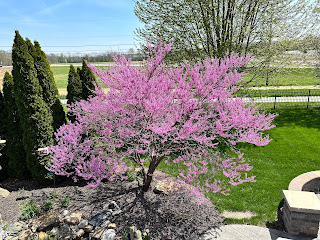Small Spaces - Pots!
Some of the best tomato plants for pots include:
- Cherry tomatoes: Cherry tomatoes are a popular choice for container gardening because they are small and compact. They also produce a lot of fruit, which makes them a good choice for people who want to have a lot of tomatoes to eat. Some popular cherry tomato varieties include Sun Gold, Sweet 100, and Black Cherry. Choosing a determinate variety (more on determinate plants in a moment!) will allow you to better plan the space needed for your plant.
- Determinate tomatoes: Determinate tomatoes are a type of tomato plant that grows to a certain height and then stops growing. This makes them a good choice for container gardening because they don't take up a lot of space. Some popular determinate tomato varieties include Early Girl, Better Boy, and Roma.
Some of the best herb plants for pots include:
- Basil: Basil is a popular herb that is used in many different cuisines. It has a sweet, peppery flavor and is often used in pesto, tomato sauce, and other Italian dishes. Basil is a warm-weather herb and needs full sun to grow well.
- Oregano: Oregano is another popular herb that is used in many different cuisines. It has a strong, oregano flavor and is often used in pizza, pasta, and other Mediterranean dishes. Oregano is a warm-weather herb and needs full sun to grow well.
- Chives: Chives are a member of the onion family and have long, thin leaves. They have a mild, onion flavor and are often used in salads, soups, and other dishes. Chives are a cool-weather herb and can be grown in pots indoors or outdoors.
- Mint: Mint is a refreshing herb that is used in many different beverages and dishes. It has a strong, mint flavor and can be overpowering if used too much. Mint is a perennial herb and can be grown in pots indoors or outdoors.
Planting tips
When choosing herbs and tomatoes for pots, it is important to consider the size of the pot, the type of plant, and the amount of sunlight the pot will receive. Most herbs and all tomato plants need at least six hours of sunlight per day, so it is important to choose a pot that will be in a sunny spot. The size of the pot will impact your plant choices.
Most herbs and tomato plants need a well-draining potting mix that is rich in nutrients. You can find potting mixes specifically designed for herbs at most garden centers. I personally prefer the Miracle-Gro product line. They have excellent moisture control potting soil that is fortified for best plant growth.
When done planting your herbs or tomato plants, it is important to water your plants regularly. Most need to be watered deeply, but not too often. Overwatering can cause the roots to rot. Also, ensure the pots you planted into have drainage holes in the bottom. On hot summer days, you may need to water more than once. It is best to water early in the day and try not to get the leaves wet.
It is also important to fertilize your plants regularly. You can use a fertilizer that is specifically designed for the plants you chose. Tomatoes will likely require more fertilizer than the herbs, as you are focused on flower and fruit development vs herbs that simply need leaf development. Regardless, you will probably need to fertilize on a more regular schedule than you would with plants planted in the ground, as the soil in your pot is not able to be as easily enriched by decomposing matter and earthworms the way your garden soil is.
One more important thing to note -
If you are growing your pots on a hard surface, such as your deck or a concrete or paver patio, some type of pot "feet" are a must! Pot feet will allow your pots to drain, and prevent staining on the surface under your pot. Additionally, the air circulation around the plant is improved, which can help to prevent the spread of diseases and pests.
There are pros and cons to the various types.
Disc or wedge foam-type pot feet
I like these, as they provide an even and stable base to the bottom of your pot. They work well for just about any type of pot, though if you pot is large or especially heavy, you may need to increase the number of feet used. For a small to medium sized pot, three pot feet is likely sufficient. The down side is that you may have some staining underneath the pot foot itself, as they often make more contact with your bottom surface. They are not as durable as some other choices, but they are inexpensive.


Comments
Post a Comment